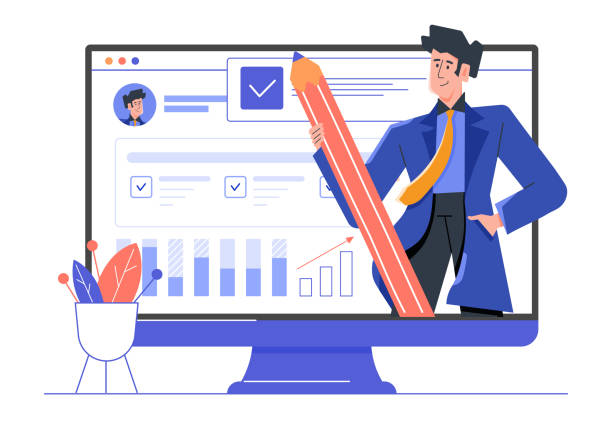Introduction to Fast Website Design and its Necessity in Today’s World
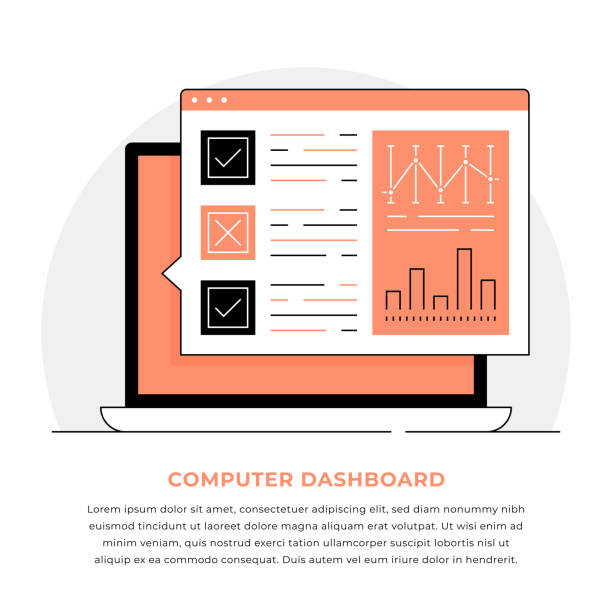
#Website speed today is not just a desirable feature, but a vital necessity for any business aiming for an effective presence in the digital space.
In a world where users seek instant information and immediate experiences, fast website design can literally make the difference between success and failure.
Slow website loading not only leads to losing visitors but also severely negatively impacts the site’s ranking in search engines.
Studies have shown that even a one-second delay in page loading can lead to a significant reduction in visitor-to-customer conversion.
From the perspective of Search Engine Optimization (SEO), this topic is a fundamental pillar, and search engines like Google consider loading speed as an important factor in page ranking.
This is important news for website owners that should be taken seriously.
The importance of User Experience (UX) is also highlighted here; a fast site provides a more enjoyable experience for users, which in turn leads to increased retention, reduced bounce rate, and ultimately, increased conversion rates.
This is a comprehensive explanation of why special attention should be paid to fast website design.
Frustrated with your e-commerce site’s low conversion rate? Rasaweb transforms your online store into a powerful tool for attracting and converting customers!
✅ Significant increase in visitor-to-buyer conversion rate
✅ Unparalleled user experience to boost customer satisfaction and loyalty⚡ Get a free consultation from Rasaweb!
Key Factors Affecting Website Loading Speed
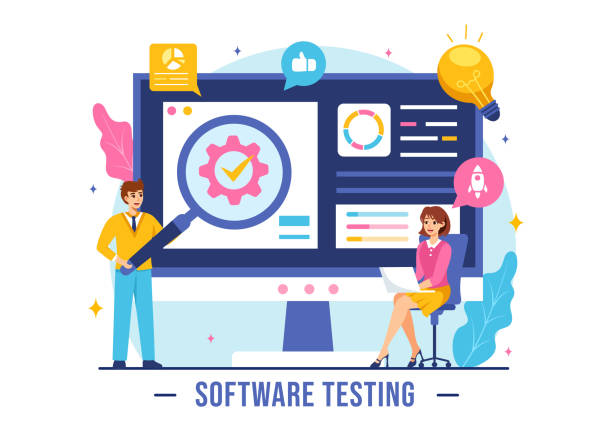
#Many factors influence a website’s loading speed, and understanding them is the first step towards optimization.
One of the most important factors is server response time.
The faster the server responds to browser requests, the sooner the loading process begins.
Image optimization also plays a crucial role; large images can severely slow down a site.
Using appropriate formats (like WebP), proper compression, and employing lazy loading for images only when needed, are among the instructive solutions in this area.
Also, optimized coding, including minification of CSS and JavaScript files and removal of extra code, helps reduce the size of transmitted data and consequently increases speed.
Using Browser Caching allows the browser to store repetitive resources (like logos, CSS, and JS) so they don’t need to be redownloaded on subsequent visits, which is very effective in fast website design.
These factors require an analytical approach and thorough examination to identify and resolve speed bottlenecks.
Understanding these factors is the foundation of any effort to create a fast-loading website.
Website Speed Analysis and Improvement Tools

#To achieve fast website design, merely knowing the factors is not enough; we must also be able to measure and analyze them.
Fortunately, powerful tools exist for this purpose that guide us in identifying our website’s weaknesses.
One of the most widely used tools is Google PageSpeed Insights, which not only provides a score for site speed but also offers practical suggestions for improvement.
GTmetrix is another tool that provides more comprehensive information, such as a Waterfall Chart, allowing you to see the loading time of each page component.
Lighthouse, also available natively in Chrome browser, goes beyond speed to evaluate other aspects like accessibility and SEO.
Using these tools is a specialized approach for accurately identifying and prioritizing issues.
#These tools help you understand which parts of your site are slow and which optimizations will have the most impact.
For example, they might report that your images are not compressed or that you have too many CSS and JavaScript files causing slow initial loading.
This information forms the basis of any effective plan to speed up your website.
Additionally, some analytical tools have a questionable content section that helps you delve deeper into your site’s technical issues and seek more creative solutions.
| Tool Name | Key Features | Main Focus |
|---|---|---|
| Google PageSpeed Insights | Core Web Vitals score, optimization suggestions, mobile and desktop user experience | SEO and User Experience (UX) |
| GTmetrix | Waterfall Chart, YSlow and PageSpeed scores, performance monitoring | Deep technical performance analysis |
| Lighthouse (Chrome DevTools) | Performance, accessibility, best practices, and SEO scores | Comprehensive web application quality assessment |
The Role of Hosting and Server Infrastructure in Fast Website Design

#One of the most important yet often overlooked factors in fast website design is the quality of hosting and server infrastructure.
Even with the best client-side code optimizations, if your server is slow or lacks sufficient bandwidth, your site will never achieve optimal speed.
Choosing suitable hosting can have a profound impact on server response time and, consequently, the overall site speed.
Inexpensive shared hosting often has limited resources that are divided among multiple websites, which can quickly lead to performance degradation.
To increase website speed, using Dedicated Servers, Virtual Private Servers (VPS), or Cloud Hosting is recommended, as they provide more resources to your site and operate more specialized.
#In addition to the type of hosting, the technologies used in the server are also important.
Using Solid State Drives (SSD) instead of HDDs significantly increases data read and write speeds.
Furthermore, utilizing Content Delivery Networks (CDN) is essential for sites with high traffic or global audiences.
CDN caches your site’s content on various servers worldwide, delivering it from the closest geographical location to the user, which dramatically increases loading speed.
This is a comprehensive explanation of the critical role of server infrastructure in site performance.
Does your company’s website perform as well as your brand deserves? In today’s competitive world, your website is your most important online tool. Rasaweb, specializing in professional corporate website design, helps you to:
✅ Build customer credibility and trust
✅ Convert website visitors into customers
⚡ Get a free consultation now!
Optimizing Images and Media for Speed Increase

#Images and media files typically constitute the largest portion of a web page’s size, and therefore, optimizing them is of paramount importance.
Without addressing this, fast website design will be almost impossible.
The first step in this direction is choosing the right image format.
Formats like WebP, due to their much more efficient compression compared to JPEG or PNG, can significantly reduce file size without a noticeable loss in quality.
For images requiring transparency, SVG is a good option for vector graphics, and PNG for pixel-based images with transparent backgrounds.
#The next step is image compression.
Numerous online and offline tools exist for image compression without significant quality loss.
Furthermore, using Lazy Loading for images and videos is very important.
With this method, images are only loaded when the user scrolls to the relevant section of the page, which helps reduce the initial load on the server and significantly increases initial loading speed.
Making images responsive, meaning providing different image sizes for different devices (mobile, tablet, desktop), also prevents bandwidth waste and provides a faster user experience.
These guidelines are crucial for anyone looking to optimize their site’s speed and clearly demonstrate how excellent results can be achieved with an educational approach.
Impact of Optimized Code and Plugins on Site Performance

#The quality of programming code and the correct choice of plugins play a pivotal role in fast website design.
Unoptimized, redundant, or heavy codes can create a significant load on the server and severely reduce loading speed.
Minification of CSS and JavaScript files means removing white spaces, comments, and extra characters from the code, which helps reduce file size and speed up their download.
Also, combining CSS and JavaScript files (if possible) can reduce the number of HTTP requests, which in turn positively affects speed.
#Another important issue is how JavaScript files are loaded.
Using `defer` and `async` attributes for asynchronous loading of scripts allows the browser to continue loading the main page content without waiting for the scripts to finish loading.
Regarding plugins, using lightweight and efficient plugins is essential.
Every extra plugin means more code and more requests to the server.
Therefore, you should only install plugins that you truly need and ensure they are built by reputable developers following optimized coding standards.
Incorrect choices in this section can lead to questionable content in your site’s performance and cause unexpected slowdowns.
This analytical and specialized approach is crucial for maintaining and improving your site’s loading speed.
Caching and Data Compression: A Path to Faster Website Design
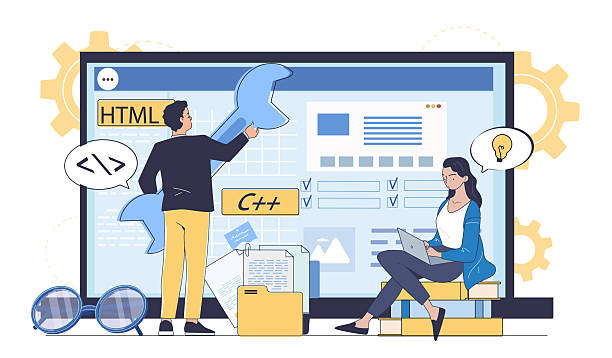
#Caching is a vital technique for achieving fast website design and optimizing website performance.
Simply put, caching means temporarily storing data or files closer to the user so that on subsequent visits, they don’t need to be reloaded from the main server.
This significantly reduces loading time and alleviates pressure on the server.
There are different types of caching, each operating at a different layer:
#Browser Caching: Allows the user’s browser to store static files such as CSS, JavaScript, images, and fonts.
On subsequent visits, these files are loaded from the browser’s local cache instead of being re-downloaded from the server.
#Server-Side Caching: This type of caching is performed on the server side and can include Page Cache, Object Cache, and Database Cache.
Page cache stores the entire HTML output of a page so that on subsequent requests, there’s no need for reprocessing PHP and the database.
#CDN Caching: As mentioned earlier, Content Delivery Networks (CDN) also deliver cached content from the closest server to the user.
#In addition to caching, Gzip compression is also a very effective method for reducing the volume of data transmitted between the server and the browser.
Gzip is a compression algorithm that can reduce the size of HTML, CSS, and JavaScript files by up to 70%.
Enabling Gzip on the server automatically compresses data before sending it to the user, and the browser uncompresses it upon receipt.
This process significantly reduces bandwidth consumption and improves site loading speed.
This explanation is essential for every web developer.
| Caching Type | Storage Location | Benefits |
|---|---|---|
| Browser Caching | User’s computer (browser) | Reduced HTTP requests, faster loading on repeated visits |
| Server Caching | Website hosting server | Reduced server-side processing (PHP, database), improved response time |
| CDN Caching | CDN Edge Servers in various locations worldwide | Reduced network latency, faster loading for global users |
Questionable Content and User Experience in Fast Website Design

#The importance of fast website design goes beyond mere technical issues and is directly tied to User Experience (UX) and even website content.
A slow website can render even the best questionable or entertaining content ineffective.
Today’s users are impatient, and if there’s a loading delay, they quickly leave the site, leading to an increased ‘Bounce Rate’.
A high bounce rate not only means losing potential visitors but also sends negative signals to search engines, which can harm the site’s ranking.
#When a website loads quickly, users spend more time exploring it, view more pages, and are more likely to engage with your content.
This engagement can take the form of reading articles, watching videos, filling out forms, or purchasing products.
Even if your content is inherently very appealing, low speed can prevent it from being seen.
Therefore, website speed optimization is, in a way, an investment in your content.
Creating a smooth and uninterrupted user experience allows users to focus on the content, not on waiting time.
This approach requires an analytical perspective that goes beyond purely technical aspects and also addresses the psychological aspects of user interaction with the website.
A fast website means respecting user’s time.
Is your company’s website as professional and trustworthy as it should be? With specialized corporate website design by Rasaweb, create an online presence that represents your credibility and attracts more customers.
✅ Build a powerful and professional image for your brand
✅ Convert visitors into real customers
⚡ Get a free consultation now!
Advanced Challenges and Solutions in Fast Website Design

#On the path to fast website design, there are also advanced challenges that require more specialized and in-depth approaches.
One such challenge is managing Render-Blocking Resources.
CSS and JavaScript files placed in the `<head>` section of an HTML document that must be loaded before the page content can be rendered can cause delays in the initial display of the page.
The solution is to include only Critical CSS (essential CSS codes for displaying the “Above the Fold” section) inline in the HTML, and load the rest of the CSS asynchronously.
#Migrating to the HTTP/2 protocol is also an advanced solution for increasing site speed.
HTTP/2 allows for sending multiple requests over a single TCP connection and also supports Header Compression and Server Push, which can significantly reduce loading time.
#Continuous performance monitoring of the website is also of great importance.
Tools like New Relic or Datadog allow you to monitor website performance in real-time, identify issues, and react to them quickly.
This analytical approach helps you keep your site always at peak speed and resolve any performance drops before they affect users.
Addressing these challenges and implementing these solutions can be a questionable content for developers, but the results in user experience and SEO ranking are significant.
Conclusion and the Future of Fast Website Design
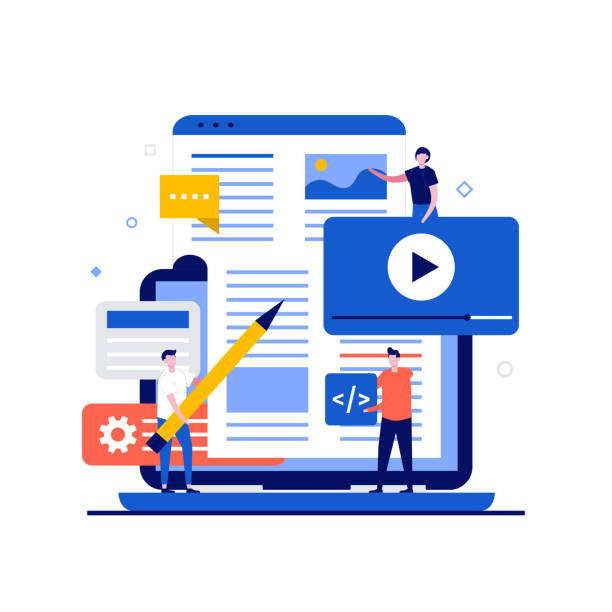
#As discussed in this descriptive and comprehensive article, fast website design is no longer a luxury option, but a strategic necessity for survival and success in today’s competitive web space.
From improving user experience and increasing conversion rates to enhancing search engine rankings and reducing bounce rates, the benefits of a high-speed website are undeniable.
We have seen how various factors, from hosting and optimized code to images and caching systems, all play a role in achieving this goal.
#The future of web speed is increasingly moving towards standards like Google’s Core Web Vitals, which provide specific metrics for measuring user experience.
The focus on Mobile-First Indexing means that Google first examines your site’s mobile version for ranking, so mobile speed has gained double importance.
To maintain a competitive advantage, businesses and developers must continuously prioritize speed optimization and treat it as a guidance and ongoing process, not a one-time task.
This is important news for all web professionals, indicating the future direction.
Continuous optimization and attention to detail are the only way to ensure your website remains leading and fast, providing the best experience for your users.
Frequently Asked Questions
| Question | Answer |
|---|---|
| What is fast website design? | A process for building a website that loads quickly and provides a smooth and optimized user experience. |
| Why is site speed important? | Increased user satisfaction, improved search engine ranking (SEO), reduced bounce rate, and increased conversion rate. |
| What factors affect site speed? | Page size, number of HTTP requests, image optimization, JavaScript and CSS codes, server speed, and caching. |
| How can site speed be measured? | Using tools like Google PageSpeed Insights, GTmetrix, Pingdom Tools. |
| How can site speed be increased? | Optimizing images, compressing files (CSS, JS, HTML), browser caching, reducing the number of redirects, choosing suitable hosting. |
| Does fast website design mean low quality? | No, fast design means designing with a focus on speed and efficiency optimization, not reducing design or content quality. |
| What is the role of hosting in site speed? | The speed and quality of the hosting server directly impact the site’s response time and, consequently, its loading speed. |
| How can images be optimized for speed? | Using appropriate formats (e.g., WebP), compressing images without significant quality loss, specifying exact dimensions for images. |
| Can complex websites also be fast? | Yes, by using appropriate architecture, optimizing codes, and managing resources, even complex sites can have high speed. |
| Is fast website design the same as Agile development? | No, fast website design focuses on the final outcome (a fast site), while Agile development is a methodology for project management and software development. |
And other advertising services by Rasaweb Advertising Agency
Smart Advertorial: A specialized service for increasing site traffic based on real data.
Smart Direct Marketing: A fast and efficient solution for increasing click-through rates with a focus on precise audience targeting.
Smart Website Development: An effective tool for online growth with the help of marketing automation.
Smart Marketing Automation: A combination of creativity and technology to increase sales through marketing automation.
Smart UI/UX: Designed for businesses seeking to analyze customer behavior through key page optimization.
And over hundreds of other services in internet advertising, advertising consultation, and organizational solutions
Internet Advertising | Advertising Strategy | Advertorial
Resources
WordPress Website Speed Optimization
Impact of Site Speed on SEO and User Experience
Introducing Free Website Speed Test Tools
10 Key Methods to Increase Website Loading Speed
? Are you looking for a major leap in your online business? Rasaweb Afarin, by providing comprehensive digital marketing services including fast and professional website design, SEO, and social media management, paves the way for your success. Experience a powerful and impactful presence in the digital world with us.
📍 Tehran, Mirdamad Street, next to Bank Markazi, Kazerun Jonubi Alley, Ramin Alley No. 6

